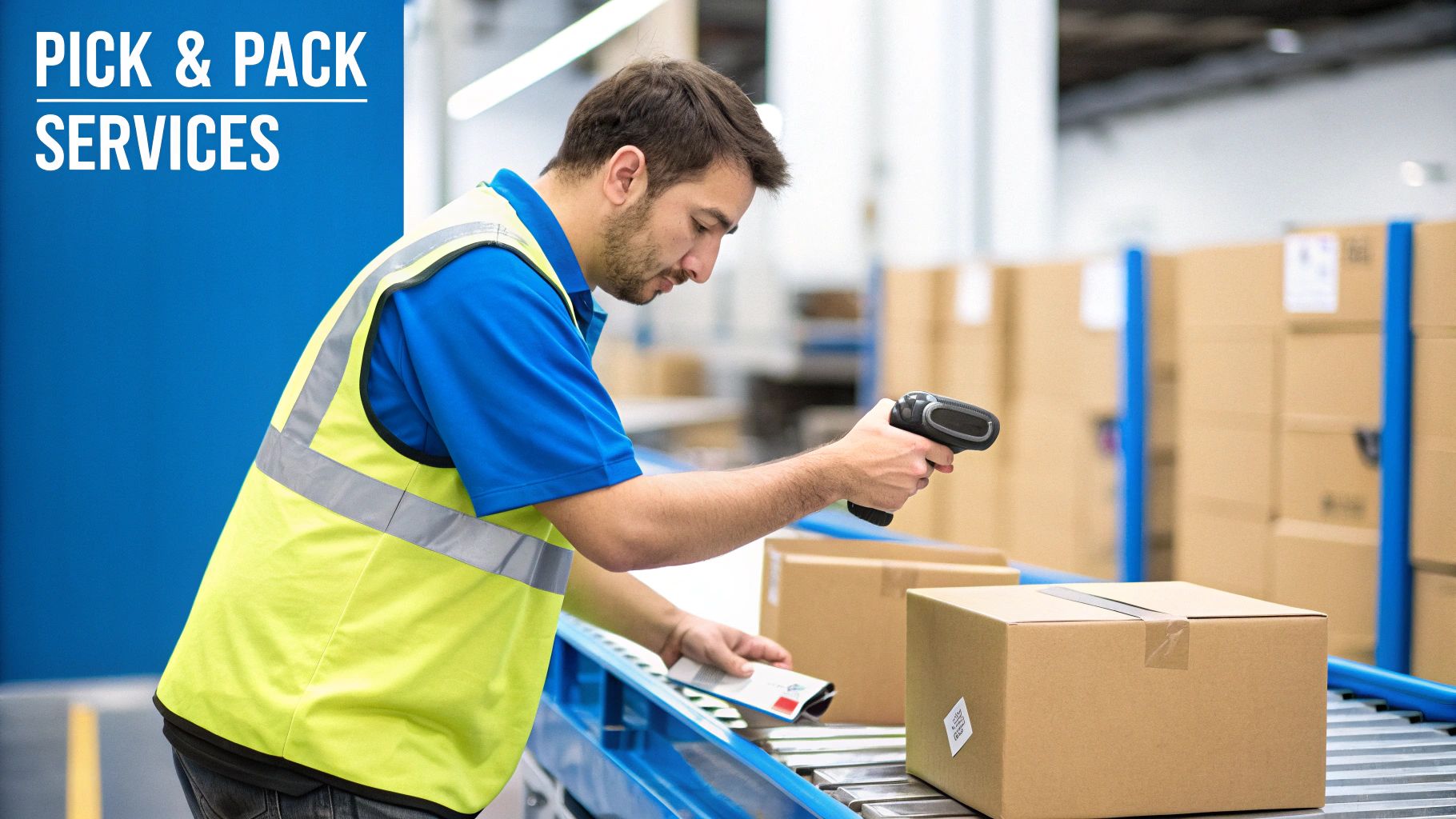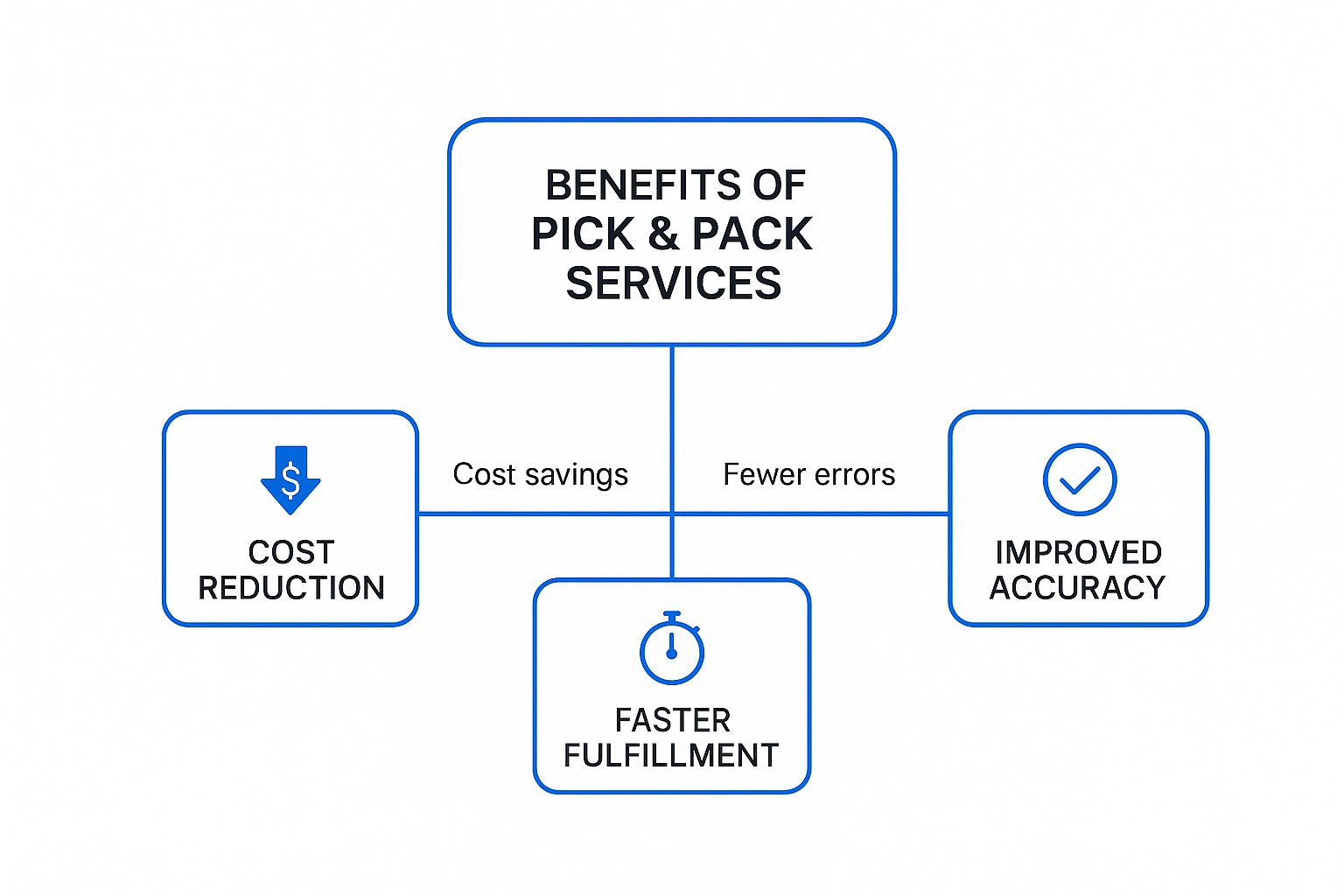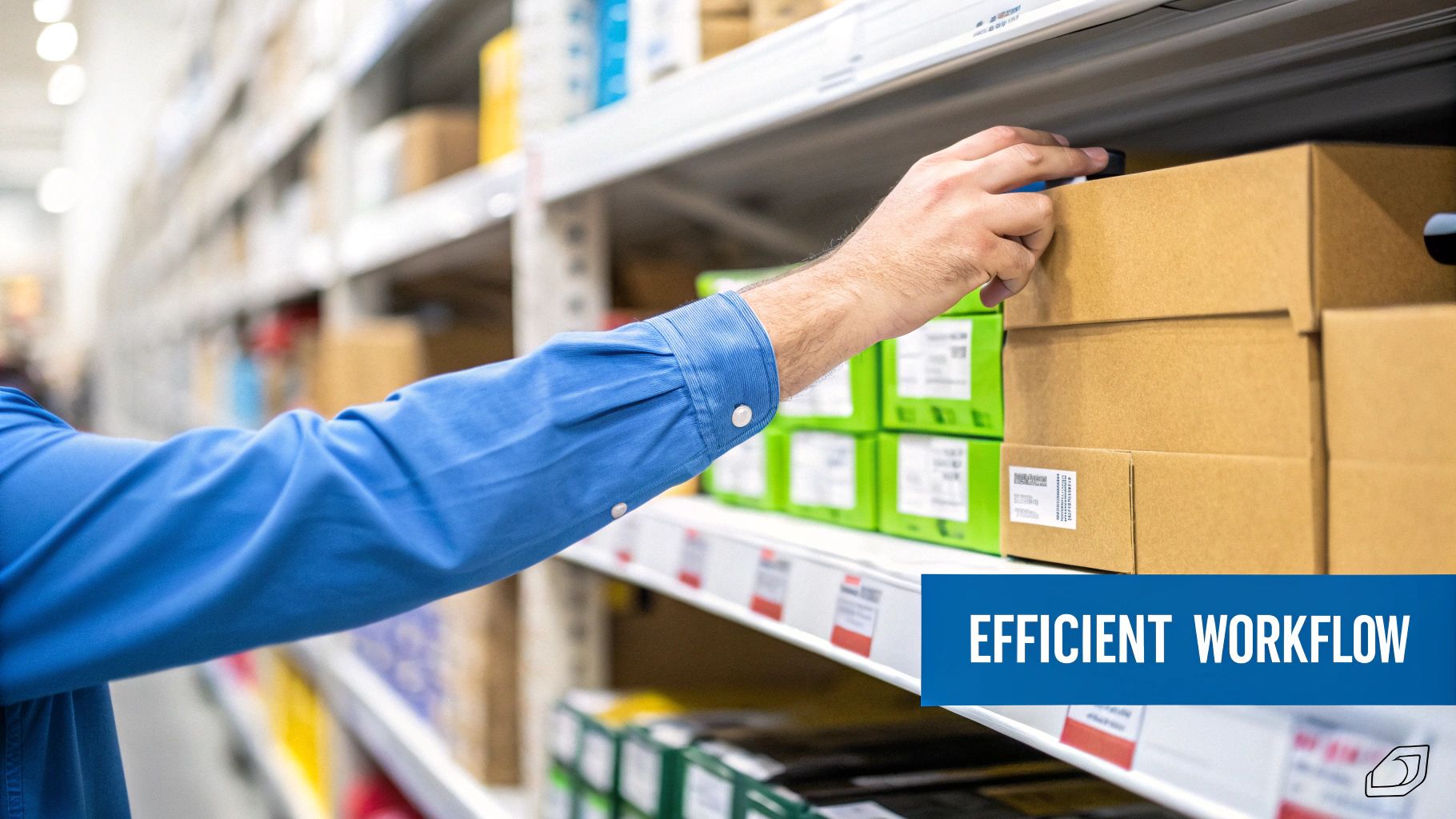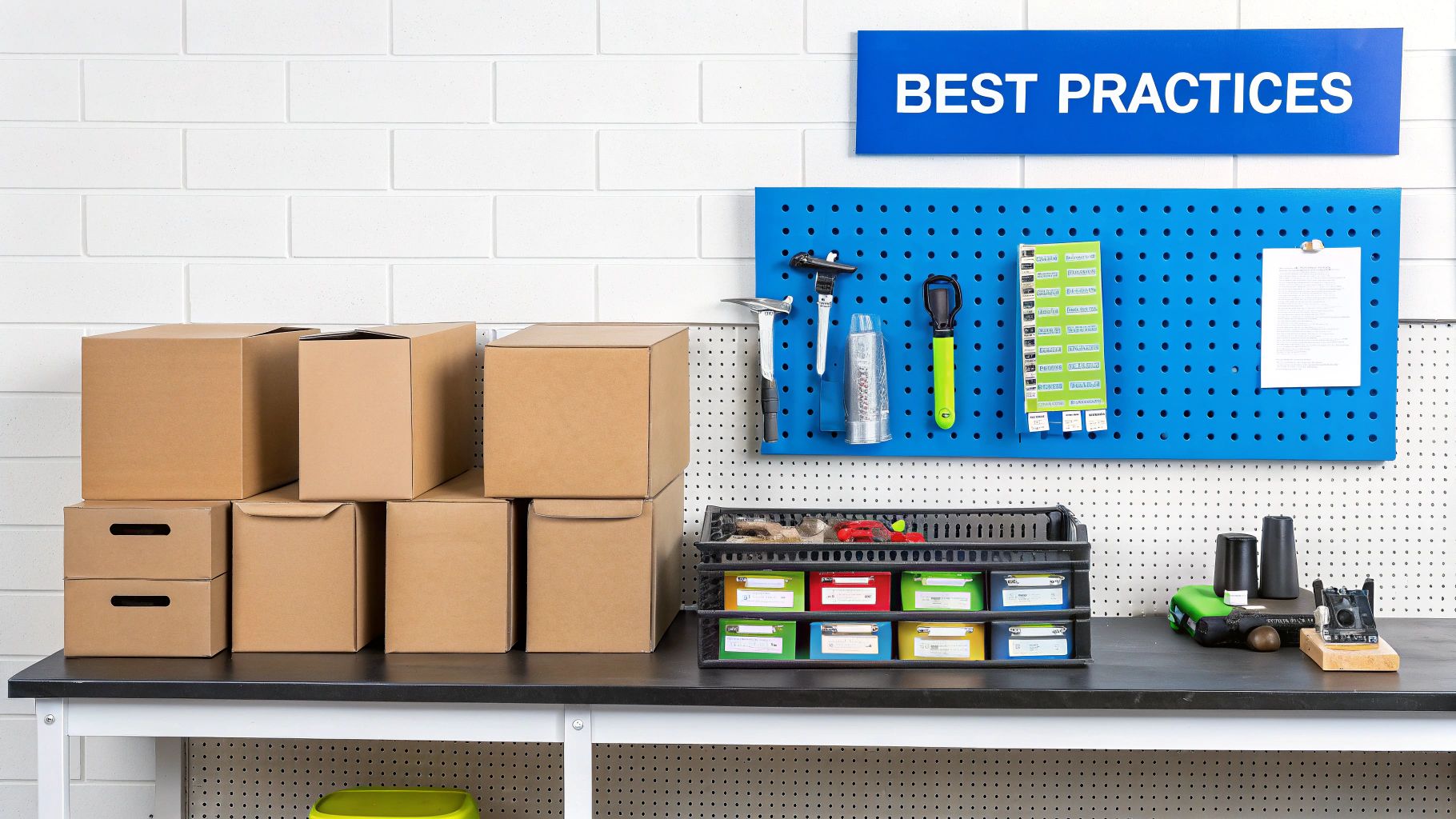Think of your e-commerce business as having a personal shopper, someone who meticulously selects every item a customer orders from vast warehouse shelves and then expertly packs it for a safe journey. That's exactly what pick and pack services do. It's the powerful operational engine that keeps modern e-commerce moving, guaranteeing both speed and precision from the moment a customer clicks "buy" to the package landing on their doorstep.

At its heart, pick and pack fulfillment is a dynamic, two-part process that serves as the backbone for getting products into your customers' hands. It's far more than just storing products; it's the active, moment-to-moment flow of goods inside a fulfillment center. You can think of it as the real-world translation of a customer's digital shopping cart.
The moment an order is placed, the "picking" process kicks off. A warehouse associate, armed with an order list, navigates the facility to gather—or pick—the exact items and quantities for that specific order. Once everything is collected, the "packing" stage begins. This involves carefully placing the products into a properly sized box with the right protective materials, sealing it up, and slapping on a shipping label.
The magic of the system lies in the synergy between these two distinct actions.
The entire pick and pack fulfillment sector is a massive component of the global warehousing and logistics market, which is on track to hit an estimated value of $869.32 billion by 2025. The explosive growth of e-commerce has put incredible pressure on these operations, as customer expectations for lightning-fast, flawless delivery just keep climbing.
Key Takeaway: In today's market, efficient pick and pack services aren't a nice-to-have; they are a fundamental requirement for any competitive e-commerce business. Your success hinges on a fulfillment partner's ability to execute these tasks quickly and perfectly, one order after another.
While it sounds simple on the surface, this process relies on complex strategies to keep things running efficiently. You can learn more about how to boost your e-commerce success with a solid pick and pack process in our detailed guide.
The table below breaks down the fundamental workflow from start to finish.
Each stage must be optimized for the entire system to function smoothly, turning digital orders into physical deliveries with seamless efficiency.
Once an order hits your fulfillment center, how do your products actually get pulled from the shelves? The "pick" in pick & pack services isn't a simple, one-size-fits-all process. Warehouses rely on several strategic methods, each with its own logic and flow, designed to wring out every last drop of efficiency based on the type and volume of orders being processed.
Getting a handle on these methods is key before you even start talking to a fulfillment partner. Think of it like choosing the right tool for a job. A hammer and a screwdriver are both essential, but you wouldn’t use them interchangeably. In the same way, picking the right strategy can make a massive difference in your labor costs and how fast your packages get out the door.
This infographic breaks down the core benefits that a well-oiled pick and pack strategy delivers—connecting the dots between lower costs, better accuracy, and faster fulfillment.

As you can see, these three crucial outcomes are deeply interconnected, all stemming from a smart fulfillment process. Let's dig into the four main picking methods that make it all happen.
Piece picking, sometimes called discrete picking, is the most straightforward method of all. Imagine you have a personal grocery list for a single recipe. You’d walk through the entire store, gathering only the items on your list before heading to the checkout.
That’s exactly how piece picking works in a warehouse. A picker takes one order, travels through the facility to collect every item for that specific order, and then brings the completed set to a packing station. It's simple to manage and works perfectly for small businesses with lower order volumes or for those dealing with complex, multi-item orders that demand careful attention.
Now, let's go back to the grocery store. This time, you're shopping for yourself and three of your neighbors. Instead of making four separate trips, you’d combine all the lists into one master list, grab a bigger cart, and get everything at once. That's batch picking.
A warehouse picker does the same, gathering items for a bunch of different orders at the same time. For instance, if 10 separate orders all need that same popular blue t-shirt, the picker goes to the blue shirt bin just once and grabs 10 of them. This drastically cuts down on travel time, making it incredibly efficient for businesses that have a lot of orders with only a few SKUs in each.
At a partner like Simpl Fulfillment, we use advanced software to intelligently group orders into the most efficient batches. This ensures our pickers take the shortest possible route through the warehouse, which directly lowers your labor costs and gets orders out the door faster.
Think of zone picking like a factory assembly line. Instead of one person building an entire car from scratch, each worker is responsible for a specific section—one person installs the wheels, another handles the engine, and so on. In a warehouse using zone picking, each picker is assigned a specific "zone" and only picks items located within that area.
Orders move from one zone to the next until all the items have been collected. If an order needs products from Zone A and Zone C, the box will pass through Zone A to get its items, skip Zone B entirely, and then move on to Zone C for the final products. This approach is fantastic for large warehouses with a high volume of complex orders because it minimizes picker movement and prevents congestion in the aisles.
Wave picking takes things a step further by blending the best of both zone and batch picking into a single, highly coordinated "wave." Here, pickers are still assigned to specific zones, but they also pick items for a batch of orders at the same time, all within a scheduled window.
This creates a synchronized flow of products moving toward the packing and shipping areas in scheduled waves throughout the day. It’s a sophisticated method that’s perfect for large-scale operations that need to manage a massive number of SKUs and orders with maximum speed and efficiency.

Once your team has picked an order's items from the warehouse shelves, the journey is only halfway done. The "pack" in pick & pack services is far more than just stuffing products into a box. It's a critical, strategic moment where cost control, product safety, and your brand's identity all converge.
Getting this stage right has a direct and measurable impact on your bottom line. An inefficient packing process can quickly inflate your expenses through wasted materials and higher shipping fees. But a thoughtful, well-executed approach transforms packing from a simple necessity into a powerful business advantage.
The biggest hidden cost in e-commerce shipping is often dimensional (DIM) weight. Carriers like UPS and FedEx calculate shipping fees based on either a package's actual weight or its DIM weight—whichever is greater. Using a box that’s too big for your products needlessly inflates this measurement, leading to significantly higher shipping costs.
An expert fulfillment partner like Simpl Fulfillment uses advanced 3D scanning technology to pinpoint the most compact and efficient box size for every single order. This precision eliminates wasted space, reduces the need for excessive void fill, and directly minimizes your shipping spend on every package that leaves the warehouse.
This isn't just about the box itself. It extends to the protective materials inside, known as dunnage.
By optimizing both box size and dunnage, a business can achieve substantial savings while ensuring products arrive safely.
Expert Insight: Inefficient packing isn't just a shipping issue; it's a financial drain. Every oversized box and handful of extra packing peanuts represents a missed opportunity to lower operational costs and improve profit margins. Optimizing the packing stage is one of the quickest ways to see a direct financial return from your fulfillment operations.
Beyond the practicalities of cost and safety lies a tremendous branding opportunity: the unboxing experience. In an age where the first physical interaction a customer has with your brand is the package they receive, this moment is invaluable. A plain brown box does its job, but a thoughtfully packed one creates a memorable, shareable experience.
This is where expert packing becomes a marketing tool. A great fulfillment partner can help you incorporate elements that delight customers and reinforce your brand identity.
Consider these impactful additions:
These small details transform a transactional delivery into a personal connection. When customers feel valued, they are far more likely to become repeat buyers and brand advocates, turning a simple fulfillment process into a powerful engine for customer loyalty. Ultimately, strategic packing ensures every order arrives both safely and impressively.
Trying to manage your own fulfillment can feel like the most straightforward path at first. But as your business grows, so does the mess of boxes, tape guns, and shipping labels. Outsourcing your pick & pack services isn't just about getting time back—it's a strategic pivot that unlocks serious advantages, letting you get back to growing your brand instead of getting buried in logistics.
When you partner with a third-party logistics (3PL) provider like Simpl Fulfillment, you're essentially plugging your business into a ready-made machine built for efficiency. It's like instantly upgrading your company with a world-class logistics department, but without the staggering upfront cost. This move is quickly becoming the standard for any brand that’s serious about growth.
And the numbers back it up. 3PLs are taking over the fulfillment world. Right now, about 60% of online retailers outsource at least part of their operations, and 12% hand over the entire process. That figure is expected to jump by 50% in the next few years as the global 3PL market barrels toward a $1.17 trillion valuation. If you want to dig deeper, you can explore more e-commerce fulfillment statistics to see just how massive this shift is.
One of the first and most obvious wins of outsourcing is how much it cuts your overhead. Running your own warehouse is a black hole for cash, demanding huge investments in long-term leases, utilities, staffing, and security before you ever ship a single box.
Partnering with a 3PL makes those massive expenses vanish from your books. Suddenly, you’re no longer on the hook for:
Instead of all those fixed costs, you shift to a variable cost model. You only pay for the services you actually use, making your expenses predictable and directly tied to your sales.
Key Insight: Outsourcing transforms the crushing fixed costs of in-house fulfillment into flexible, variable expenses. This frees up precious capital that you can pump back into marketing, product development, or other initiatives that actually grow your business.
For any growing eCommerce business, demand is anything but steady. You’ve got seasonal rushes, viral marketing hits, and unpredictable growth spurts that create huge spikes in order volume. For an in-house team, handling that kind of surge without tanking your service quality is nearly impossible.
Outsourcing gives you the elasticity to handle these swings without breaking a sweat. A good 3PL has the space, staff, and systems to absorb a sudden flood of orders and keep things running smoothly. This means you can scale way up for Black Friday and then scale right back down in a quiet month, all without disruption or wasted money.
This kind of flexibility is what sustainable growth is built on. It gives you the confidence to chase new markets and launch big campaigns, knowing your fulfillment operations can handle whatever you throw at them. If you're thinking about making the switch, our guide on how to outsource pick, pack, and ship operations breaks down the entire process.
A dedicated fulfillment partner lives and breathes logistics. Their entire business is built around one single goal: getting the right products to the right customers, as fast as humanly possible. That level of specialization results in performance that’s incredibly tough to match on your own.
Expert 3PLs like Simpl Fulfillment use sophisticated inventory management software and barcode scanning at every single touchpoint. This obsessive focus on process minimizes human error and drives exceptionally high order accuracy rates. Fewer mistakes mean fewer expensive returns and a lot more happy, loyal customers.
On top of that, their streamlined workflows and deep relationships with shipping carriers mean faster processing, often including same-day fulfillment. Fast shipping isn't a perk anymore; it's a fundamental customer expectation. Meeting that demand leads directly to better reviews, more repeat business, and a real competitive advantage.

For any ecommerce brand looking to outsource fulfillment, seeing a quote from a third-party logistics (3PL) provider for the first time can be a bit of a shock. The list of line items can feel complex and intimidating. But once you pull back the curtain, you'll see that pick & pack service pricing isn't arbitrary—it’s a direct reflection of the physical work and resources needed to get your products off the warehouse shelf and into your customer’s hands.
Think of it like an itemized receipt for a service. Each charge ties back to a specific action, like unloading your inventory, keeping it safe on a shelf, or paying the team member who physically picks and packs an order. Grasping this structure is the key to accurately forecasting your expenses and choosing the right partner with confidence.
While the exact names might differ slightly from one 3PL to another, most invoices are built around the same few service categories. Getting familiar with these will help you read any quote like a pro.
You can almost always expect to see these main charges:
Other costs can pop up for things like the initial account setup, packaging materials like boxes and dunnage, or special projects like building product bundles (kitting).
Simpl Fulfillment believes in straightforward pricing with absolutely no hidden fees. We give you a crystal-clear breakdown of all potential costs, so you always know exactly what you're paying for and can manage your budget without any surprises.
The way your orders are structured dramatically changes your fulfillment costs. Shipping lots of small, individual packages directly to consumers (B2C) is a very different beast than shipping large, palletized orders to other businesses (B2B).
B2C fulfillment involves a high frequency of individual item picks, while B2B fulfillment means less frequent but much larger orders that often demand special labeling and documentation to meet retail compliance standards.
This table breaks down how the cost factors differ between the two models.
As you can see, the operational demands of each model lead to fundamentally different pricing structures for picking, packing, and shipping.
Finally, when you're adding everything up, don't forget to include the cost of actually shipping the package out the door. Using a shipping calculator tool can help you estimate these outbound logistics costs. This gives you a complete picture of your total fulfillment spend, from the moment your product hits the warehouse to the second it lands on your customer's doorstep.
Picking a third-party logistics (3PL) provider isn't like choosing a new office supplier; it's a strategic move that can define your brand's reputation for years to come. Think of the right partner as a genuine extension of your team, dedicated to getting orders to your customers accurately and on time. The wrong one? They can become a source of constant headaches, leading to shipping delays, costly mistakes, and a slow erosion of customer trust.
Making the right choice means you have to look past the price tag. You need to get into the weeds of their operations, their technology, and their core philosophy to see if they truly line up with where you want to take your business. Getting this foundational step right is non-negotiable for scaling successfully.
In today's eCommerce world, technology is the central nervous system of any good fulfillment operation. A provider's tech stack has a direct, daily impact on their efficiency, accuracy, and your ability to see what's happening with your inventory. The first thing to check is their integration capabilities. Your potential partner absolutely must connect seamlessly with your eCommerce platform, whether you're on Shopify, WooCommerce, Amazon, or another marketplace.
This connection needs to be more than just a one-way street; it requires real-time, two-way data flow. When a customer places an order, it should pop up in the 3PL’s system almost instantly. When that order ships, tracking information should automatically sync back to your store and get pushed out to the customer. This level of automation is what kills manual data entry, slashes errors, and keeps everyone in the loop.
Key Consideration: Does the provider give you a dashboard or portal that’s actually easy to use? You need to see your inventory levels, order statuses, and returns in real-time. A partner like Simpl Fulfillment provides a clean, intuitive interface that puts all this critical data at your fingertips, so you can make decisions based on facts, not guesswork.
Let's be clear: not all pick & pack services are the same. A warehouse that’s a pro at shipping t-shirts might be completely lost when it comes to handling fragile electronics or regulated beauty products. Finding a partner with proven, hands-on experience in your specific product category is vital.
Don't be afraid to ask direct questions about their experience with products like yours.
Working with a specialist means they already know the unique challenges your products face. This expertise minimizes risk and ensures your items are handled the right way from the moment they arrive to the final delivery. This is a key part of our guide on the 7 proven ways to scale your ecommerce business, because a specialized partner can grow with you without creating friction.
Finally, you need to move from promises to proof. This is where Service Level Agreements (SLAs) come into play. An SLA is a firm, contractual commitment that outlines the provider's performance standards. You have to get clear, specific answers on what they guarantee.
Ask these questions directly to vet them properly:
A partner who is truly transparent won't hesitate to share these metrics. More importantly, they’ll provide regular reports to prove they're hitting their targets. This accountability is the bedrock of a healthy, long-term fulfillment partnership.
Even after you've got a good handle on the basics, it's natural to have a few more specific questions about how pick & pack services really work day-to-day. Let's tackle some of the most common ones we hear from business owners.
This is a great question because people use these terms interchangeably all the time, but they serve very different purposes.
Think of a traditional warehouse as a place for long-term, static storage. It’s a holding area where pallets of products sit, often for weeks or months. Its job is simply to store things.
A fulfillment center, however, is a dynamic hub of constant activity. It's designed for speed and inventory flow, actively managing the entire process of getting orders out the door. It connects directly to your online store, processes orders as they come in, manages your inventory levels in real-time, and ships everything out. It’s essentially a warehouse that’s been supercharged for the demands of modern e-commerce.
The initial investment can vary quite a bit from one provider to the next. Some 3PLs will have a one-time onboarding fee. This usually covers the tech side of things, like integrating their warehouse management software with your Shopify or WooCommerce store. You’ll also have an initial cost for receiving and checking in your first shipment of inventory.
After that, your ongoing costs are typically broken down into monthly storage fees (based on how much space you use) and per-order fees for the actual picking and packing. It’s absolutely critical to get a detailed quote that breaks down every single potential charge. This way, you can build an accurate forecast and avoid any surprises down the road.
Kitting is a smart, proactive strategy where a fulfillment center assembles multiple individual products (each with its own SKU) into a single, ready-to-ship bundle before a customer even orders it. It’s perfect for things like gift sets, subscription boxes, or promotional product bundles.
Key Insight: Kitting is a massive time-saver for bundled products. By pre-building popular kits, your fulfillment team only has to grab one item off the shelf instead of hunting down several. This drastically cuts down on labor time and speeds up order processing, which is a lifesaver during busy periods like Black Friday or other holidays.
Absolutely. Any comprehensive 3PL partner will manage customer returns, a process often called reverse logistics. This isn’t just an add-on; it's a critical part of the customer experience and a reflection of your brand's quality.
A good fulfillment partner has a solid system for the entire returns journey:
How a 3PL handles returns is a great indicator of their overall quality. A smooth, transparent returns process shows they understand the full e-commerce lifecycle, not just shipping things out.
This all comes down to the provider’s Service Level Agreement (SLA), which is their formal promise on performance. Top-tier fulfillment centers, like Simpl Fulfillment, often guarantee same-day shipping for any order that comes in before a specific cutoff time (like 2 PM, for instance).
When you’re vetting potential partners, this is a non-negotiable question. Ask for their specific SLAs on order processing speed and their documented accuracy rates. You need to be sure their performance can meet your customers' expectations for fast, reliable delivery—it's essential for earning trust and encouraging repeat business. A provider's willingness to commit to and report on these metrics speaks volumes about their confidence and capabilities.
Ready to stop worrying about logistics and start focusing on growth? Simpl Fulfillment offers transparent pricing, same-day shipping, and a dedicated team to handle every detail of your pick and pack operations. Discover how we can help your brand scale.